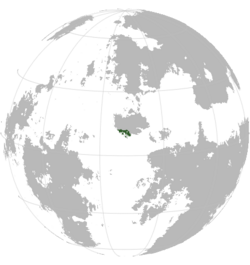Iarisuko
| Republic of Iarisuko Iạrisúkọ́ |
||||
|---|---|---|---|---|
|
||||
| Capital and | Iarisuko City | |||
| Official languages | Iarisuko Nyigoi Nkanjum |
|||
| Government | Some flavour of republic | |||
| Establishment | ||||
| - | De jure controlled by the Letsatian Empire | 25-180 CE | ||
| - | Founding of the first centralized city-states | 200s CE | ||
| - | Formation of the Yaañitsuko Dynasty | 708 CE | ||
| - | Height of the Yaañitsuko trade cycles | Early 1200s | ||
| - | Yaañitsuko trade cycles cease | 1330 CE | ||
| - | Conquest by the Aituxe State | 1661 CE | ||
| - | Dissolution of the Aituxe State | 1781 CE | ||
| - | Unification under the Magalese Republic | 1860 CE | ||
| - | De jure independence from Magali | 1922 CE | ||
| Area | ||||
| - | 138,602 km2 53,515 sq mi |
|||
| Population | ||||
| - | estimate | 19 265 678 | ||
| - | Density | 139/km2 360/sq mi |
||
Iarisuko (Iarisuko: iạrisúkọ́ [IPA]), officially the Republic of Iarisuko, is a country located in Akulanen and neighbouring the Taanttu Sea to the south and west, Magali to the north and Amerhan to the east. While the land that is now Iarisuko has spent most of history being disputed between Magalese and Amerhani polities, it was the center of the Yaañitsuko Dynasty between 708 and 1330 CE. The Yaañitsuko had an expansive trade network, ranging as far as Dhwer and maybe even Lhavres.
Etymology
The name comes from the Ghoni *yàŋu-ʒwúk-wâ, probably meaning "fortress" (lit. long-tall-G23). It is thought to refer to the local practice of building fortified inzynds, perhaps already due to Iarisuko's historical position as a border land.
History
While the region has seen human activity for many thousands of years, as the earliest human migrations out of Ekuosia happened through Akulanen, the earliest records of what archeologists believe might be ancestors of, or at least related to, modern groups of the region are the earliest inzynd mounds in the northern coasts of the country, usually dated within the first millenium BCE. Written records begin around 25CE with Letsatian presence in the region. Letsatian records show many coastal settlements. By the very fragmentary linguistic evidence they are believed to belong to early Ghonoid groups. On the wake of Letsatian activity and occupation, coastal city states focused on naval trade arose during the second century, reusing some of the leftover Letso-terminian infrastructure.
The Yaañitsuko Dynasty is founded in 708CE and centralizes many of the city states along the following century. On the ninth century they establish naval contact and trade with the Haraku Dynasty of the Siakua islands, starting the Yaañitsuko Trade Cycle in earnest by expanding their trade relationships into Upper Boroso. While most of the direct trade was with the Siakuans, items from much farther away have been found on the historical and archeological record, such as Dhweran paper and Kavrinian cocoa. Magalese polities grow in naval power and begin to impinge on the Yaañitsuko trade lanes over the thirteenth century and the Trade Cycle collapses entirely by 1330. Scholars do not fully agree on the causes of this collapse. The most common account credits the dissolution of the Great Dhweran Empire in 1215 and the subsequent political fragmentation of the region with increasing the bureaucratic and political barriers to Yaañitsuko trade while simultaneously diminishing the demand for the goods they offered. Other theories cite increased competition with Magalese or even Mahic polities over naval trade, with some scholars even arguing it came down to tensions with the Dalar populations which provided much of the naval expertise of the Yaañitsuko trading apparatus.
Iarisuko would then be strongly affected by the 1483 Akulanen Earthquake which destroyed much of its urban infrastructure, shifting the region away from international trade for the following centuries, even as Dhweran and Bavkiri sailors reached the area directly. In the 17th century the region comprising modern Iarisuko, along with parts of western Amerhan was conquered by the Aituxe State, ruled from the mountains of central Magali. They would enjoy a period of independence after the dissolution of the Aituxe in 1781 but would eventually be brought back into Magalese rule in the 1860s. The Magalese Republic was administratively very fragmented, with not much power de facto at the hands of the federal government, and a sense of Iarisukan identity harking back to the golden age of the Yaañitsuko Trade Cycle flourished in the period.
The Modern Thought revolution which took over Magali between 1918 and 1921 failed to consolidate the territory now corresponding to Iarisuko, to which many Magalese politicians fled. Because of that, and since it preserved most of the government institutions of the Magalese Republic, twentieth century Iarisuko is often considered the successor of the Magalese Republic and were initially very hostile to Modern Thought.
[Insert helsonia and GEW stuff, also modern vibes. Did the anti-MT/CC vibes make it through being next to helsonia? more at eleven]

